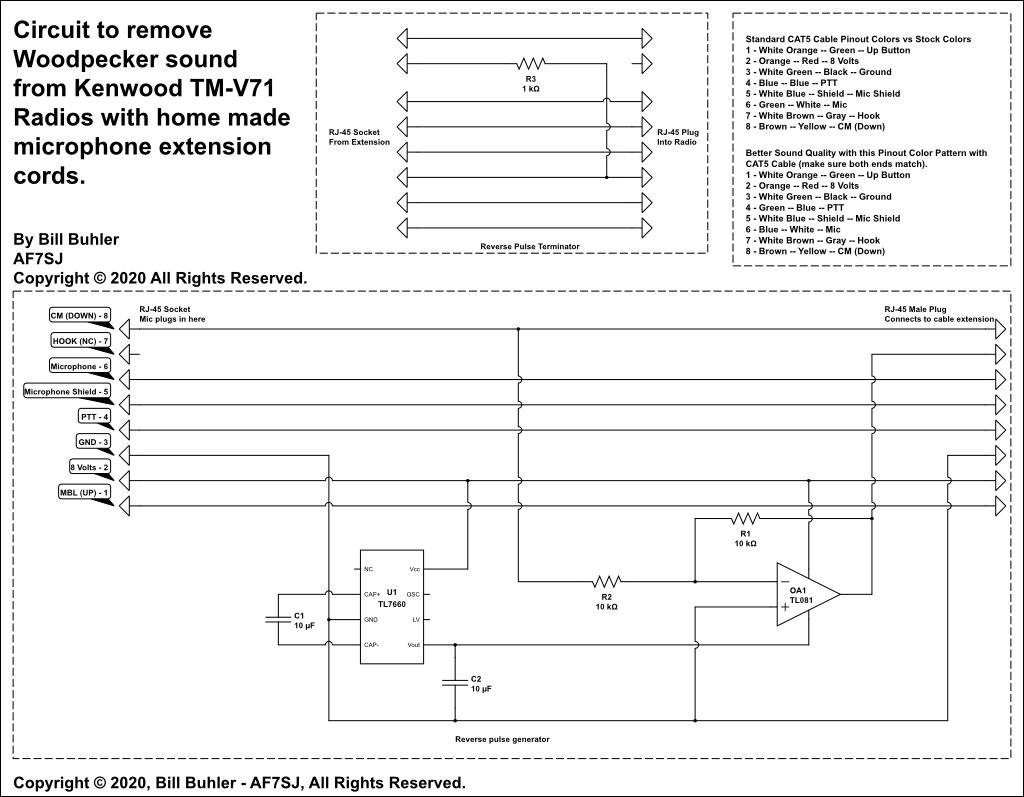Kenwood TM-V71a Removing Wood Pecker Sound From Mic Extension
My father in law, K7DRB, came up from Phoenix in July to witness my daughter get baptised. While he was in town I setup his truck for his TM-V71a by adding power cables from his battery to the back section of his king cab for power. Then I ran double shielded cat6 cable to between there and the drivers area / center console for the control head and microphone.
This took a lot longer than I had anticipated but I felt was very clean and professional looking. Our first test was with the doors open and David calling on the radio, while I listed to my HT. It sounded really good, but there was a lot of background noise. So we closed off the cab and tried again. This time I could hear a constant clicking sound.
After sleeping on it Sunday after church we tried again with David reving the motor while not talking. I could hear the clicking steadily without a change in frequency or pitch. After searching online I discovered that the TM-V71a was described as getting a woodpecker sound if the mic cord was extended. This is blamed on a clocking signal sent to read the DTMF keys.
David was out of time so I promised I would research a solution for him. My first approach was to see if running a balanced line between the microphone and the radio without the coiled cord made a difference. On my radio the woodpecker was there in force. So I scratched that as a solution. It did make for some good learning about balanced audio and what kind of amplification is needed to remove common mode interferrence. I find myself wondering why the radio manufacturers aren't using a balanced circuit to begin with...
So I decided I would need to convert from unbalnced at the microphone, to balanced for the extension, and the finally back to unbalanced. I could do that with transformers, but there will be losses, and at mic levels those could be substantial. But since the radio provides 8 votlts DC to the micrphone, I figured I could steal a little bit of that to do the conversions with some opamps. So I designed a opamp based differential amplifier with signal buffering and unity gainto go between the extension cable and the radio:
Initial tests with it still passed through the pulsing signal, and no other audio. I then added a transformer at the mic end and still no audio. My next step will be active amplification / balancing on the mic end. But I'm suspicious that the op amp I bought from Radio Shack isn't working correctly.
16 August 2016
OK, so after a lot more experimenting I think I found a much simpler solution. It just so happens that the serial data causing the pulsing noise is on the orange pair, white orange wire. The orange wire is not connected at the radio or the microphone. So I built a quick inverting buffer circuit to go at the microphone end, and terminated the radio end through a resistor to the ground wire. Now I can faintly hear the pulsing if I turn up the receiving radio almost all the way, but it's pretty faint. Without a oscilloscope I don't know how much the reduction is, but it's dramatic.
So at this point I'm debating whether I should borrow a oscilloscope and measure both signals, or if I just move forward. I do know that David and Sherri have left Phoenix for their house in Alberta, and will be by in a few weeks. So that is my firm deadline to solve the issue.
Later on
Let me report on my final solution. I borrowed a Oscilloscope from Bob Carter - WR7Q - and built a negative power supply + op amp circuit which when the 5 volt pulse is sent down the orange wire sends a -5 volt pulse to the far end, which is then terminated to ground with a resistor. This put the pulsing sound down about thirty db on the oscilliscope. I gave the finished curicuit to David and he reported clean audio reports with his friends in AZ.
For those that are interested in doing the same thing, here is a schematic of my solution:
